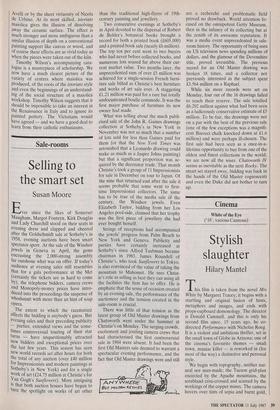Crafts
Ceramic Art of the Renaissance (British Museum, till 20 September)
Masterly maiolica
Tanya Harrod
The fluctuating fortunes of maiolica in the art market form a curious little chapter in the history of taste. Collectors have always turned to maiolica as a relatively cheap and powerfully evocative link with the Renaissance in Italy. The coats-of-arms Large maiolica dish made in Deruta (near Perugia) about 1500-20 and personal imprese on a whole range of pieces provided excitement for antiqua- rians — Walter Scott's Mr Oldbuck would certainly have kept a few examples in a dusty cupboard. The fact that maiolica used to be known as `Raffael ware' is a clue to another of its charms. Pioneer collectors like the erudite linguist Sir Andrew Foun- taMe of Narford Hall thought that the narrative or istoriato scenes on the grand- est 16th-century examples were actually
painted by Raphael el alia, rather than adapted from their designs. 'Earthern ware set on shelves from top to bottom, a great deal of it painted by Raphael Urbin,' noted a 1738 Narford inventory. In addition, maiolica always seems to have attracted the kind of semi-superstitious gossip which intermittently has had a dramatic effect on the value of works of art. For example, Rudolf II owned a Hispano-Moresque vase which he believed had been used for the miraculous celebrations at Cana. In the early 19th century the delightful Cafag- giolo plate in the V & A of a maiolica painter was fancifully thought to depict Raphael at work portraying his beloved Fornarina.
By the mid-19th century, maiolica's reputation in England was at its height and it was held up as an improving example to our manufacturers. 'One of the most im- portant categories of industrial or decora- tive art which the world has yet seen,' wrote one commentator solemnly. It was partly in this pedagogic spirit that the impressive collections in the V & A and in the British Museum were formed. The whirligig of taste explains why the latter collection ceased to expand after 1925: between the wars, both in and out of museums, early Chinese pottery was the most highly regarded. By then, maiolica had unhappy Victorian associations, whereas Tang or Sung looked suitably at home with Brancusi in a chic modern collection. The studio potters of the day were snooty about maiolica too: 'weak,
ornate and closely allied to third-rate Renaissance painting,' noted Leach in A Potter's Book.
Of course, Renaissance pottery has tended to be overshadowed by the painting
and sculpture of the period, however retar- dataire or provincial. But Ceramic Art of the Renaissance is bound to sweep away
those kind of prejudices simply because it illuminates so many aspects of 15th- and 16th-century Italian cultural life.
The exhibition is dominated by the museum's fine collection of maiolica, but
examples of Hispano-Moresque lustre, in: cised slipware and Medici porcelain are also included. (Until recently all these
treasures have been hidden away in store but now a major permanent gallery is being planned.) A mass of associated material, principally the maiolica painter's design sources in the form of engravings, wood- cuts and photographs, both of relevant
paintings and of alla grottesca decoration, puts the pieces in context. The Three Books of the Potter's Art, a 16th-century
manuscript written and charmingly illus- trated by the virtuoso pottery enthusiast Cipriano Piccolpasso, is also on display.
Purists may prefer the grand simplicities of Hispano-Moresque lustre or the white
and blue 'oak leaf' pharmacy jars of the quattrocento. But it is hard not to be delighted by the painterly landscapes and obscure allegories of Francesco Xanto Avelli or by the sheer virtuosity of Nicola de Urbino. At its most skilled, istoriato majolica gives the illusion of dissolving away the ceramic surface. The effect is much stronger and more ambiguous than a similar illusion of depth on a conventional Painting support like canvas or wood, and of course these effects are as vivid today as When the pieces were taken out of the kiln.
Timothy Wilson's accompanying cata- logue is a masterpiece of scholarship. We now have a much clearer picture of the variety of centres where majolica was produced, of the roots of the istoriato style and even the beginnings of an understand- ing of the social structure of a maiolica workshop. Timothy Wilson suggests that it should be impossible to take an interest in the Renaissance in Italy and to ignore its painted pottery. The Victorians would have agreed — and we have a good deal to learn from their catholic enthusiasms.



















































 Previous page
Previous page